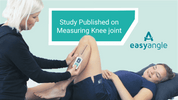-

, by Marko Dombi Athlete-Centric Care: Elevating ACL Rehab with Next-Gen Performance Tools
-

, by Marko Dombi Launch of the EasyBase - Force Plate System For Rehabilitation and Sports
-

, by Marko Dombi Interview with the researcher | Enhanced Paper Grip Test Project
Study Published on Reliability of using EasyAngle to measure Knee Joint
- , by Jerker Skogby
- 2 min reading time

Researchers at the Sports Trauma Research Center at Stockholm’s Karolinska Institutet have just had a study published on reliability of using EasyAngle to measure knee joint range of motion. Traditional goniometers are difficult to use and this results in many therapists “eye-balling” to estimate ROM rather than quantifying angles with accurate measurements. When EasyAngle was launched in 2016, this changed the game for physical therapists giving them a tool that would allow them to quickly and accurately measure range of motion with at a hand free to support the patient.
With physical therapy, patient goals are functional rather than quantitive. Good range of motion is required for normal activities of daily life, like walking, climbing stairs, tying your shoe laces etc. When patients present for treatment, it is the functional goal that they are focused on, however, the quantification of the ROM gives a baseline as to their current status as well as a marker for progress as they move through their rehabilitation. Range of motion is also important for athletes, with a few degrees of improvement having the possibility of increasing performance. Limited ROM in athletes can also result in injury.
Study Objectives
The primary objective of the study was to investigate the reliability of using EasyAngle for measuring knee joint angles considering both inter- and intra-rater reliability. A further objective was to investigate if there were any differences between novice and experienced therapists in taking measurements. If accurate measurements can be taken, particularly between raters, this would prove EasyAngle to be a powerful tool in the hands of Physical Therapists in the course of their normal daily work.
Study design and results
Passive knee joint measurements were taken with the knee in fixed position. Twenty participants were included in the study equaling forty knee joints. The study was carried out by two registered physical therapists, Melanie Svensson and Marita Löfgren Harringe. Both physical therapists were blinded to the measurements throughout the study. Results were very good for both Intra-rater (ICC 0,997-0,998) and Inter-rater (ICC 0,994). There was no statistical difference between the novice and experienced assessor.



